Interesting anecdotes from Bucker history
- Written by: Administrator
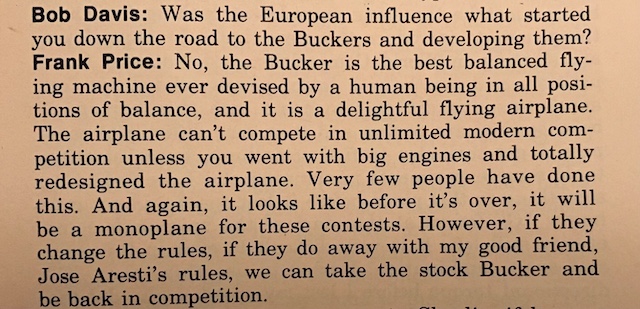
- Written by: Administrator
The Bréguet XIV may not be as glamorous or quite as well known as some WW 1 aircraft, but it is a very special and successful aircraft none the less. A light bomber and observation aircraft it was faster than many scout/pursuit aircraft of the day. Designed by Louis Bréguet, variants used several types of engine, including the immense Liberty V12.
Gilles recently had the unimaginable privilege of flying a Bréguet and answering my recent request for some European content sent the following report, presented here in both the original and my best guess English translation:
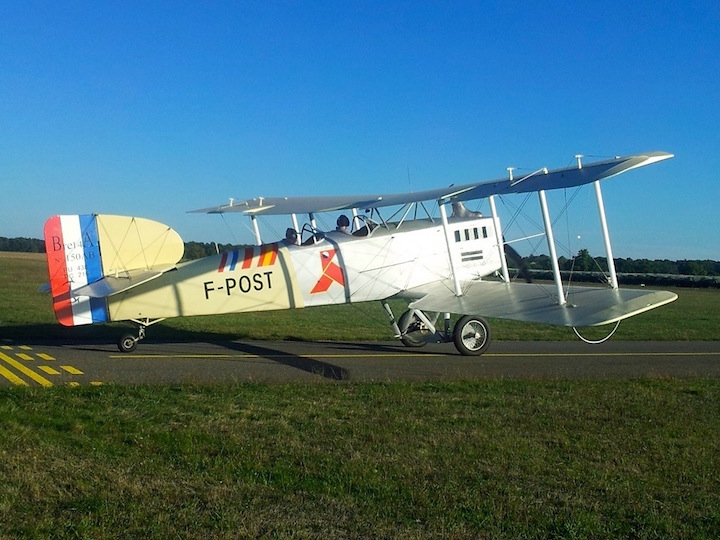
Un peu de vent d’autan, pas vraiment gênant sur la piste 10 avec une dizaine de kt stables. Une visi et une lumière magnifiques et une chaleur estivale plus vraiment de saison fin octobre, même si c’est la traditionnellement la belle saison par ici dans le Sud-Ouest.
On est tout seuls à voler, un méchant NOTAM interdisant l’accès aux avions non basés jusqu’à 18h, même si le personnel affecté à de mystérieuses mesures acoustiques a déserté son camion pour anticiper son week-end dès la fin de la matinée! Et dire que j’ai dû y aller en voiture, pour rien!
La bête est impressionnante, immense, haute, et lourde: 2 tonnes à sortir du hangar et à mettre en l’air grâce à 50 m2 de voilure...
La face avant est une insulte à l’aérodynamique, gigantesque et bien perpendiculaire au vent relatif. Les grandes ouies de sorties d’air de refroisissement témoignent de quelques difficultés de mise au point avec les températures moteur. L’hélice est monumentale, à l’échelle du bestiau. La curieuse cornemuse d’échappement est fonctionnelle et crache un vigoureux nuage de fumée noire au démarrage du Lycoming 350 CV bien caché derrière la façade en porte de hangar.
A bit of "vent d’autan" is blowing, a southerly wind well known in this part of France but not really a problem on runway 10 with a steady ten knots. Clear skies, good visibility and a summer like temperature . Truly late October is beautiful here in the Southwest.
There is a nasty NOTAM in effect denying access to non based aircraft until 18:00 hrs, although the guy who enforces this has deserted his truck to start his weekend at the end of the morning! And to think that I drove rather than flew here for nothing!
The beast is impressive, huge, high and heavy 2 tons out of the hangar and with 50 sq meters of wing ...
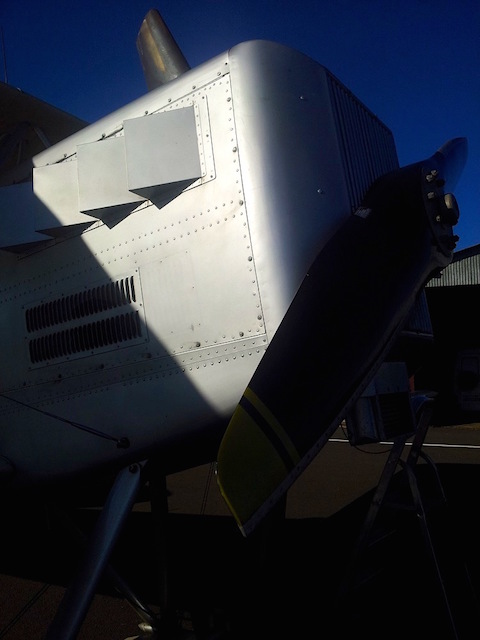
The nose is an insult to aerodynamics, gigantic and just about perpendicular to the relative wind. Large cooling air outlets indicate some difficulty with engine temperatures. The propeller is monumental in scale. The curious rhino horn exhaust pipe is functional and spits out a cloud of thick black smoke when starting the 350 hp Lycoming engine, carefully hidden behind the front door of this garden shed of a cowling.
Les deux paires de mâts de chaque côté entrainent un haubannage inhabituel, et des forêts de cables se croisent partout et dans tous les sens dans une sorte de Mikado dont la rationnalité échappe à priori.
L’aile inférieure est probablement plate, mais donne une curieuse impression de dièdre négatif d’assez mauvais aloi.
L’accès à la place pilote tient de l’escalade d’une falaise, à l’aide de marchepieds creusés dans les flancs: plus facile néanmoins que d’en redescendre, car là il faut retrouver les marchepieds à tâtons, en marche arrière et sans les voir.
La place pilote est immense, on pourrait presque y mettre deux personnes côte à côte confortablement. La taille et le débattement du manche sont à l’échelle, à tel point que l’on doit enlever les bretelles des épaules et se pencher en avant pour atteindre la butée manche avant! Luc me rassure: en vol on ne risque pas d’avoir besoin d’un tel débattement... Tiens, curieux, le manche a deux poignées parallèles! Luc me dit que je comprendrai pourquoi...
Très haut perché, on y a une belle vue sur l’extérieur. Un peu moins vers l’avant, mais infiniment mieux, quand même, que de la place arrière d’un Bücker!
The two pairs of struts on either side lead to a unusual bracing system, and a forest of cables criss-crossing everywhere and in all directions in a kind of Mikado whose design defies logic. The lower wing is probably flat, but gives the odd impression of having anhedral.
Entry for the pilot is like climbing up a cliff with steps carved into the sides: nevertheless it is easier to get in than to get out again, for then one must regain the footsteps groping in reverse and without being able to see them.
The cockpit is huge, you could almost put two people side by side comfortably. The size and throw of the stick are such that one must remove the shoulder straps and lean forward to reach the down elevator stop! Luke reassures me: in flight is not likely to need such a movement ... And, curiously, the stick has two parallel handles! Luke said I would understand why ...
Sitting very high up, there was a beautiful view outside. A little less to the front, but infinitely better than from the back seat of a Bücker!
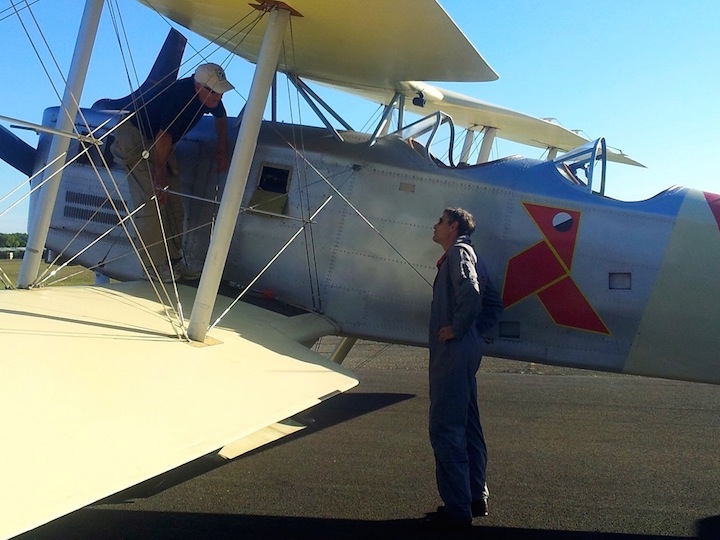
Luc me briefe rapidement depuis la place arrière: les paramètres sont simples. Montée à 130, croisière à 130, approche et atterrissage à 130. Kilomètres/heure, oui.
Démarrage sans histoire mais bruit et régime inhabituels du 6 cylindres réducté.
Roulage classique d’un train classique à roulette de queue folle: à coups de freins et de gaz, que j’essaie difficilement de garder mesurés.
Décollage sans histoire, les ailes immenses portent bien mais le moteur peine à faire monter cette énorme masse et à tirer cette énorme voilure: ça monte tout doucement donc, faut juste pas être pressé.
La profondeur est assez lourde mais très stable, le réglage du trim et la tenue de vitesse sont très faciles et plaisantes y compris à l’approche et l’atterrissage qui sont sans problème.
Le gauchissement, par contre, est très lourd et là, on comprend tout de suite la raison du manche à deux poignées: on est bien content d’y aller à deux mains pour le contrôle latéral, d’autant que le Bréguet n’est pas du tout stable sur cet axe. Il embarque en permanence et tenir l’inclinaison nulle est une occupation de tous les instants, vraiment fatigante! On repense à l’aile inférieure et on se conforte dans l’idée qu’un peu de dièdre aurait sûrement aidé... De plus les deux seuls ailerons sur cette immense voilure sont bien peu efficaces: bref, on galère un peu.
Luc briefs me quickly from the rear seat: the numbers are simple. Climb at 130, 130 cruise, approach and landing at 130 kilometers/hour :)
Starting is uneventful though the sound from the six cylinder geared engine is somewhat unusual.
Take off requires the typical rudder and some brake as I try to keep straight. We are off without drama, the huge wings are doing well but the engine struggles to climb this huge machine: it goes up slowly so you just need to not be in a hurry.
It is quite stable in pitch and the elevator trim makes it easy to maintain the proper speed, approach and landing being no problem.
Roll, by comparison, is very heavy and now we understand why the two handles on the top of the stick: it takes both hands to the control it, especially as the Bréguet is not stable at all in this axis. It wanders all the time and takes constant input to keep the wings level, really tiring! Thinking back to the lower wing it is hard not to conclude that a little dihedral would surely have helped ... And having only two ailerons on the huge wings are ineffective at best.
Tout cela ne donne certes pas envie d’aller faire des virages à 60 degrés d’inclinaison, mais en virant à 15 degrés et en anticipant beaucoup les trajectoires on guide quand même la grosse bête assez précisément en tour de piste et on y prend vite plaisir: on trouve quelques instants pour goûter la vue des vergers du Tarn et Garonne qui défilent lentement sous l’immense voilure et la forêt de câbles désordonnée. La position très haute du poste de pilotage, avec les yeux proches du plan de l’aile haute, donne l’impression de voir l’avion de dessus, presque comme si l’on n’était pas dedans. C’est très étrange, vraiment inhabituel...
L’approche est très facile, parfaitement stable. Quel bonheur: jusqu’à l’arrondi, on voit la piste!! Le pilote de Bücker en est tout émerveillé... Pas de doute, ça aide. L’arrondi non plus n’est pas difficile, garder l’assiette 3 points en vision périphérique et tirer, tirer le manche à deux mains jusqu’au menton pour la conserver malgré la diminution de vitesse, et ça touche gentiment 3 points, on repart pour un touch and go.
Un autre tour de piste confirme les impressions du premier, et l’atterrissage complet est vraiment sans problème. Luc avait insisté sur la nécessité d’être très actif au palonnier pour l’empêcher de partir en cheval de bois incontrôlable. Je suis donc très vigilant, mais comme il roule tout droit sans histoire, je me contente de ne surtout rien faire et tout se passe très bien.
Retour au parking émerveillé, conscient d’avoir vécu un moment exceptionnel sur une machine vraiment atypique. Quelques pensées historiques sur l’évolution de la conception des avions, leurs qualités de vol et pour nos anciens qui ont défriché la Ligne avec ces machines au caractère si particulier, autrement sollicitées par des conditions de relief et d’aérologie sans commune mesure avec mon vol d’aujourd’hui... Tout a été dit et écrit sur ces pionniers, mais jamais jusqu’à présent je n’avais réalisé qu’ils devaient aussi disposer de réelles qualités athlétiques!
Un grand, grand merci à Luc pour son invitation!
All this certainly discourages 60 degree banked turns, but banking at 15 degrees and anticipating the behavior of this big beast allows for some quite precise turns and we quickly settle down and find a moment to enjoy the view of the orchards of the Tarn and Garonne marching slowly under the huge canopy and the forest of messy cables. The high position of the cockpit, with the pilot’s eyes almost in line with the top wing gives the impression of seeing the plane from above, almost as if we were not in it. It's very strange, very unusual ...
The approach is very easy and perfectly stable. And what joy during the the flare - we can see the runway !! The Bücker pilot is quite amazed ... It certainly helps. Rounding out is not hard either, maintain the 3 point attitude, keep the runway edges in the peripheral vision and pull, pull on the stick with both hands almost to the chin to keep the nose up despite the decreasing speed, and it touches gently on 3 points, we depart for a touch and go.
Another circuit confirms the impressions of the first one, and completing the landing is really no problem at all. Luc had stressed the need to be very active on the rudder to stop it from swinging. I am very vigilant, but as it rolls straight uneventfully, I don’t need to do anything in particular and everything is goes well.
Back on the ramp I am amazed amazed, conscious of having experienced a fantastic time in a truly unique machine. Some historical thoughts on the evolution of aircraft design, flight qualities and thoughts of our forebears who patrolled the lines with these machines in such different circumstances to my flight today ...
Much has been said and written about these pioneers, but not until now did I realize that they were also real athletes!
A big, big thank you to Luc for the invitation!
You can learn a whole lot more about this wonderful old aircraft here: http://en.wikipedia.org/wiki/Breguet_14 and http://www.breguet14.org/html/f_post.htm
- Written by: Administrator
Fernando Siveris Xavier has sent some pictures of famous Brazilian aerobatic pilot Alberto Bertelli.

PP-TEZ was piloted by Alberto Bertelli, the leading ace of the Brazilian acrobatics. He died in his sleep during December 1980.
Your aircraft is today on display at the Brazilian Aerospace Museum.
It is one of the most beautiful stories of aviation that I know. Alberto Bertelli and his Bucker were inseparable.
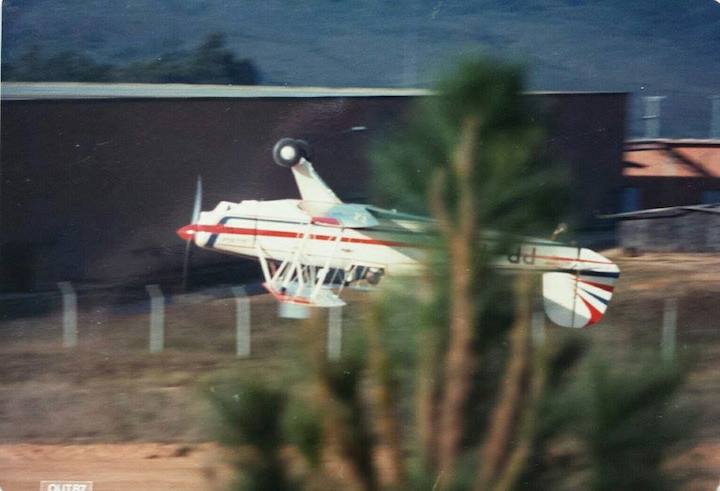
His ability to fly the Bücker, mainly performing acrobatics, was so exceptional that it was the only CIVIL flying permitted in the Air Demonstration Squadron of the Brazilian Air Force, popularly known as "Smoke Squadron".
Fernando Siveris Xavier.
There are some Youtube videos of Alberto Bertelli's flying. I particularly like this one that shows just what could be done with the "standard" German airframe and 100 HP Hirth engine.
Thank you Fernando
- Written by: Brian Karli
I was fortunate to be able to spend a few days at Bates Airfield loading the Jungmeister into its container bound for England. Once the container door had been closed and locked, we sat down at the kitchen table and enjoyed a late dinner. After some wonderful conversation, Marcus Jr. and his wife Robin mentioned the boxes of pictures in the office upstairs. I was graciously permitted to glimpse into the Bates family history. It was a privilege which I will always cherish.
I asked Marcus Jr. how his dad ended up importing so many Buckers and Bucker parts. "Dad was a patent agent and a friend in Washington told dad about the sale. Not wasting any time, he flew to Spain and went to the auction. I think he ended up buying about 20 Jungmanns on his first trip. Later, mom and dad went back to Spain and brought back a few containers of engines and parts."
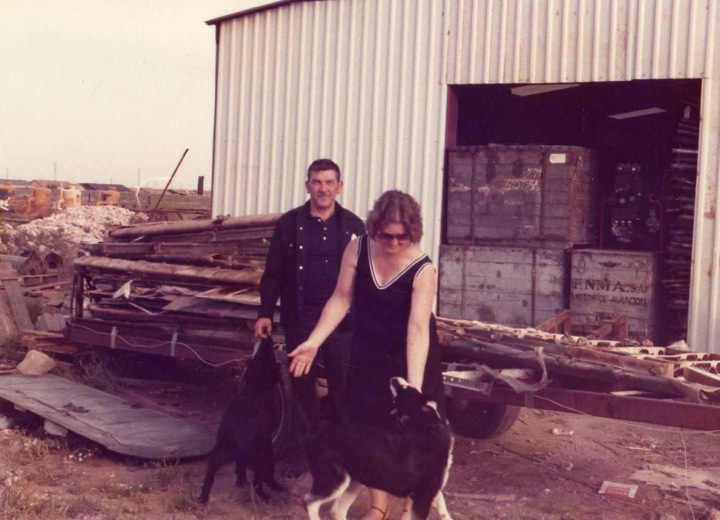
"We were living in Odessa at the time and dad rented a building close to the Sleimeyer Airport. That's where we kept everything." Robin smiled at me. "I drove the forklift," she said, "and unloaded each of the 100+ engine crates into the building. And I was pregnant at the time with our daughter too," she laughed.
Marcus Jr. continued the story. "Eventually we moved to the airstrip. Dad bought a mile square piece of property and began building his dream. Mom kept beautiful gardens and the Bucker business moved into the large hangar next to the airstrip."
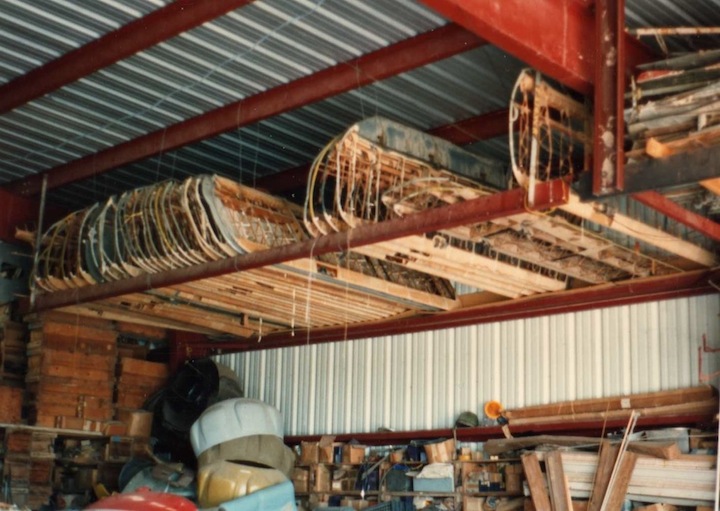
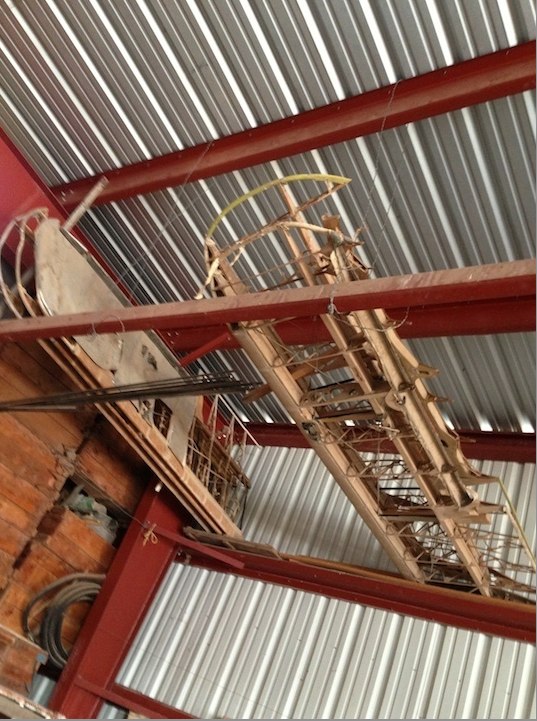
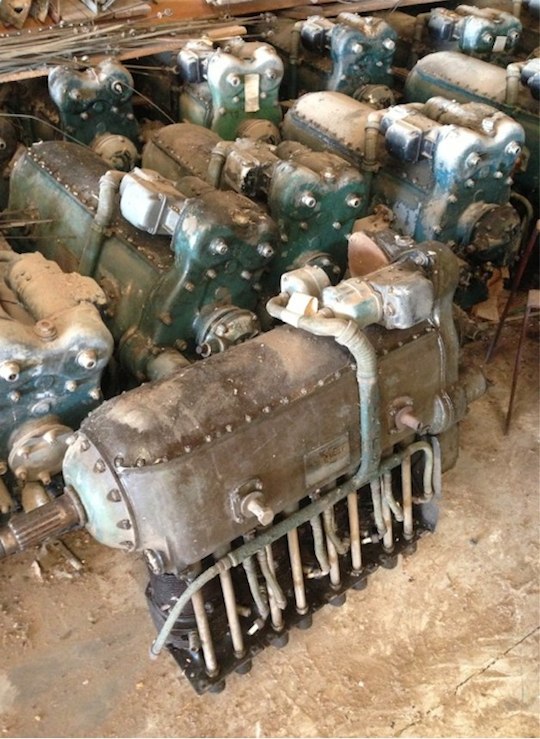
"Around 1979, dad picked one of the Jungmanns and put it together to fly. Mom flew the Jungmann by herself on January 20th. "
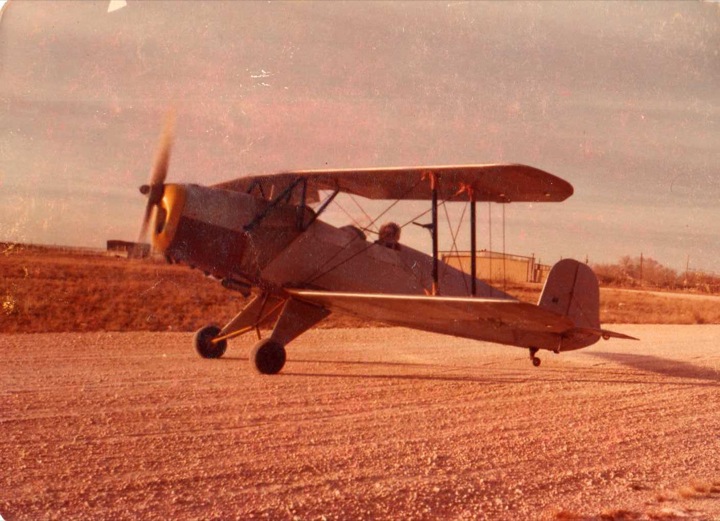
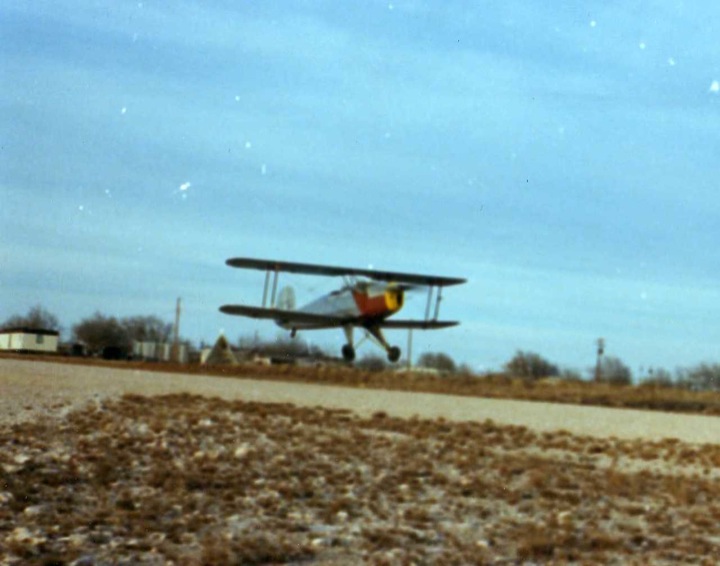
"Over the years, mom and dad had many flying adventures together. As kids, we tagged along. All four of us boys became pilots."
Marcus Jr. and Robin told me many funny stories that night. "Dad and mom went to Romania when they heard some Antonov AN-2's were for sale. A local guy showed them around the factory and they walked down the line of parked AN2's. At the end of the day, the man said to mom, "So, which one do you want?" "All of them," she said. And that is how the Bates family came to own nearly a dozen AN2's.
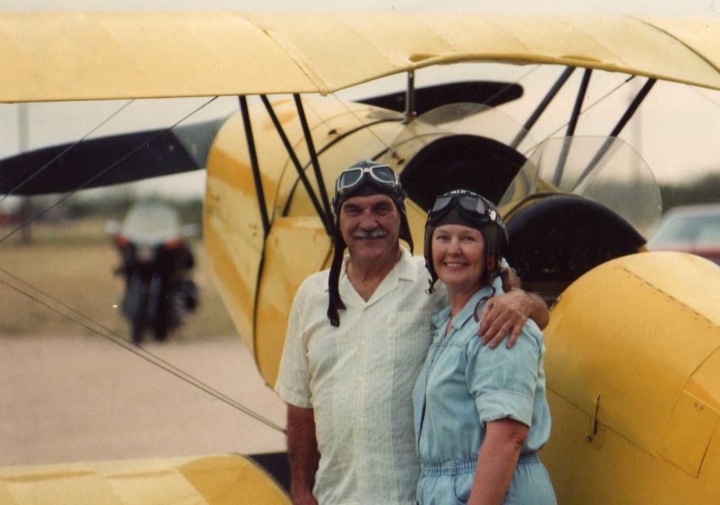
As I poured through the boxes of pictures, one photo stood out. It is a poignant photo of Marcus and Joann standing next to their yellow Jungmann in 1991. If a picture is worth a thousand words, this one is worth two thousand. Marcus is gone now, and Joann lives in an assisted living home. But that evening, they were alive and well in a box of family photos. Thank you Marcus Jr. and Robin for allowing me into their lives and seeing a piece of US Bucker history.
Brian
- Written by: Administrator
"The system employs ground based radar to survery the airspace and displays the information on a screen. The radar stations are located about as close together as current VOR stations The radar presentation is overlayed by a detailed low level map and the combined image is tramsmitted to a display in the aircraft cockpit.
Each aircraft in the area shows up as a tear-shaped blip on the display with the tail of the blip indicating direction and speed. A radial line on the display allows the pilot to determine which blip is his own aircraft. The pilot therefore has a low altitude chart in front of him at all times and can see his own progress as he travels along the airways, as well as the location of other trafic around him."
Why is this so interesting? Because author and aircraft designer Fred Weick saw it demonstrated by the RCA corportation in the fall of 1946. Sadly, the system (which was called "Teleran") did not find favor with the CAA who adopted VOR and OMNI systems instead.
- Written by: Brian Karli
Brian Karli Researched the matter and dug up some interresting history:
Great photos and story! More than likely, the Jungmeister did not survive the war. After doing some research, I have found there are no original German Jungmeisters remaining today. They are all Swiss or Spanish airframes. Unfortunately, surplus German war material was broken up for scrap right after the war. My guess is that the Jungmeister met the same fate. It's a shame, though. Think of what might have been...
Anyway, I found out a lot about Albert Falderbaum.
Your dad was right. Albert Falderbaum was the German Aerobatic Champion in 1938 and 1939 flying Jungmeister D-EQOA. He also flew Jungmeister D-EHKU. Could the Jungmeister behind your dad be one of these airplanes? Before the war, all the Jungmeisters were owned by the German National Flying club Deutsche Luftsportverband. Since there weren't that many Jungmeisters, undoubtedly Albert flew all of them.
Albert Falderbaum came from a sporting family and grew up in Niederpleis, Germany. At an early age, he developed a love of flying by building model airplanes. From the age of 14 he began soaring in Bonn.
In 1934, Albert joined the German Air Force. He used this opportunity to develop his skills in aerobatics. During the 1937 German Aerobatic Championships in Dortmund, Albert came in second place.
The next year, Albert came in first place and again in 1939 despite feeling the effects of an acute appendicitis.
During the war, Albert continued his work as a flight instructor, the focus of his work was in the blind flying training of pilots. As the war drew to a close, Albert flew the rocket powered ME163 and jet powered ME262. He became the Staffelkaptan of Erganzungsstaffel JG400 and eventually Gruppenkommanueur in February 1945. During this time he suffered a serious back injury when his aircraft exploded.
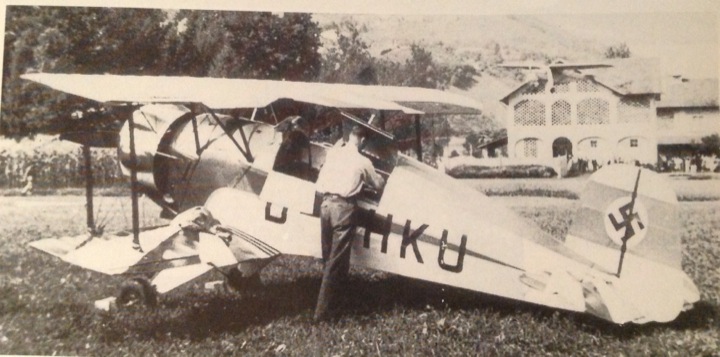
After the war, private flying was banned in Germany. Albert took a job in the chemical business but not to be deterred, Albert continued flying in Switzerland. When flying was allowed again 1955, Albert began giving aviation demonstrations and became the German Aerobatic champion again in 1960...flying a Jungmeister.
He continued to fly airshows throughout Europe. Here is a link showing Albert flying a glider inverted down a runway. Unfortunately, he clipped the tail!
http://www.britishpathe.com/video/glider-crash
1955 - Air field at Dusseldorf, with Albert Falderbaum's glider as it takes off. CU. Spectators watching. GV. Glider flying swiftly upside down just above the ground - the tail of the glider touches the ground and it is torn off.
Albert ended up in a coma for 14 days!
Unfortunately, my research yielded Albert's death. He was employed as a test pilot for a new sport aircraft, the Siebel Siat 222. On September 29th 1961, he took off from the airfield in Augsburg to conduct spin testing. Unable to recover, Albert bailed out but his parachute snagged the tail and pulled him to the ground. He was 48 years old.
Looking at these pictures of Albert, notice the coloration around the cowl bumps. The same coloration is seen on your dad's Jungmeister picture. Perhaps this is D-EHKU after all?
Anyway, it was fun researching a piece of Bucker history. Thanks for sharing your dad's pictures.
Brian
- Written by: Administrator
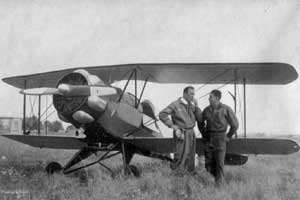
September of 1951 found Frenchman Fred Nicole in Lausanne, Switzerland on the shores of Lac Leman (lake Geneva) and he was thinking about a new trick for his airshows. Inverted flight was his specialty, but he was looking for something more spectacular. Early one morning he flew out over the lake with the local debris spotting aircraft and once in the center (presumably to stay out of trouble with both the Swiss and French authorities) he rolled inverted over the calm surface and eased down until he was mere inches above the water.
At the moment he judged right, he set full power and pushed gently forward dipping the fin into the water and holding it there, creating a long "rooster tail" of spray as the fin of his Jungmeister dragged through the water!
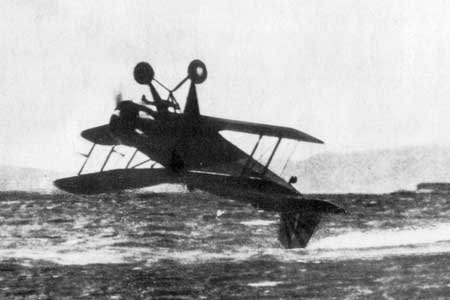
Fred Nicole off the coast of Cannes on the French riviera on Sept 9th 1951
It must have taken some nerve to perform this maneuver at any time, but can you imagine trying it for the very first time?
Fred Nicole died in Paris in February 1997 at age 86.
An update from David Martin:
Just saw the pictures of Fred Nicole on the website, his Jungmeister was the one I bought from Jay Sieler in 1990, I sold it in the late 90's. I was told by Jay that it was a German airplane that was buried during war to keep it from being destroyed.
It was acquired by Nicole sometime after the war and rebuilt. I was never able to find much information to confirm this. I do believe it was a German airframe, none of the sheet metal was original, and I think the wood had all been replaced. If the currant owner ever rebuilds it maybe he will find more clues when the fabric is removed. Think I do have an original photo of it somewhere. Here is a photo just before I sold it.
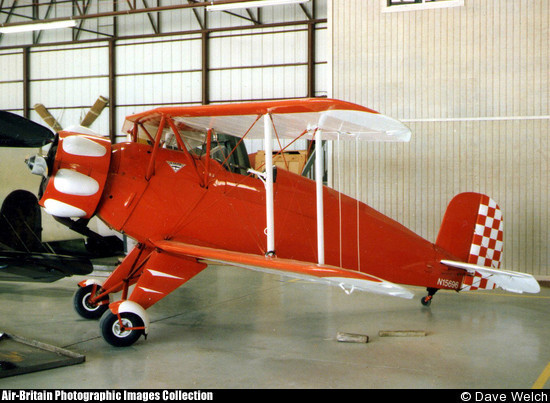
David
- Written by: Gilles Tatry
Biancotto was a French test pilot and great aerobatic champion. He died in 1960 in Bratislava while training for the WAC, when his Nord 3202 pitch control broke in flight.
On the Jungmann's fuselage is written the names of the airfields where he displayed the Jungmann, and the trophies he won in Coventry in 1955, 1956 and 1958. There is a special mention for his record of 1 hour and 16 minutes of inverted flight in 1957, a record which was only beaten in 1974 (by John Legatt, over Arizona).
The registration was F-BCSY. After he died his Jungmann was (and still is) owned by Lucien Canu, who has been my aerobatic instructor. The Hirth engine once failed and Lucien succeeded in landing on the best place he could find under his wings, which happened to be works in progress for making a large runway: the Jungmann then became the very first airplane to land at Charles de Gaulle airport! The engine was replaced by a 180 HP Lycoming, and the registration changed to F-PCSY (where F-P is for Experimental). This is as you can see her in my story "Restoring F-PGLT" (Note the front seat covering on both pictures, to make it a one-seater).
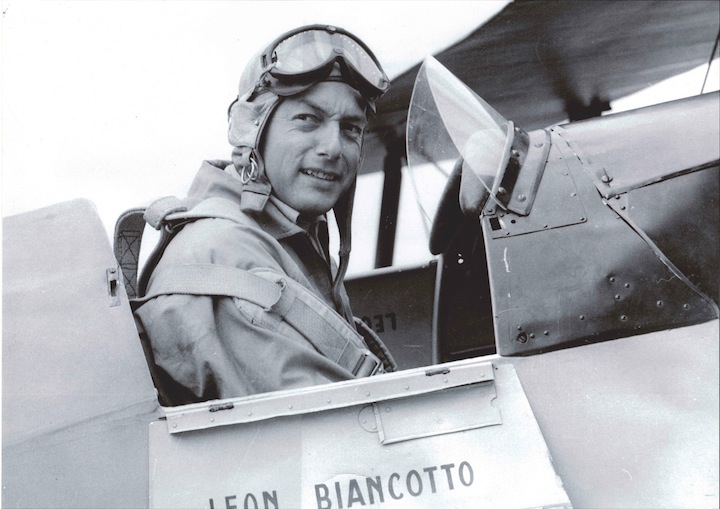
Both of the following pictures were taken on a particular occasion: September 19th, 1959 in Etrepagny (Normandy). For his homebuilt Bébé Jodel's maiden flight party, Julien Selosse-Gougeon hardly dared to invite his idol Léon Biancotto and did not even think he would accept. When he arrived at the airfield for the party, Léon and his wife Lucienne had already landed there with the jugmann! When they removed their flight suits they appeared dressed Leon in a diner jacket with bow tie, and Lucinnne in a white skirt suit and pearl necklace. Julien was deeply honored and moved. (You can see him behind the Jungmann with the headset, and bowing to Lucienne while Léon is talking to the parish priest). After her husband died Lucienne became a famous journalist for Aviation Magazine International. She recently died in a car crash.
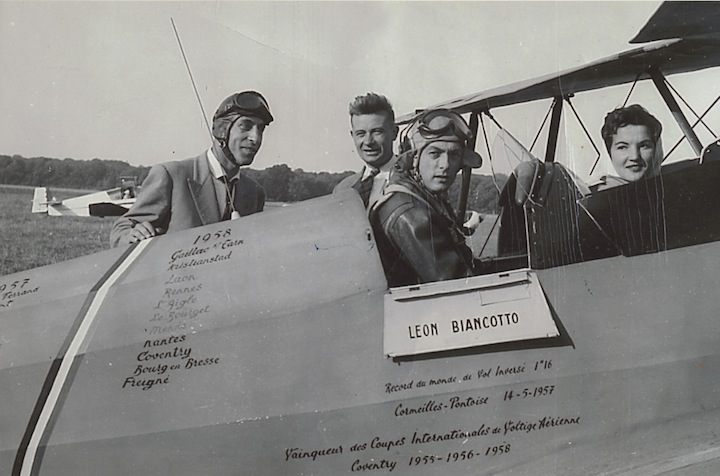
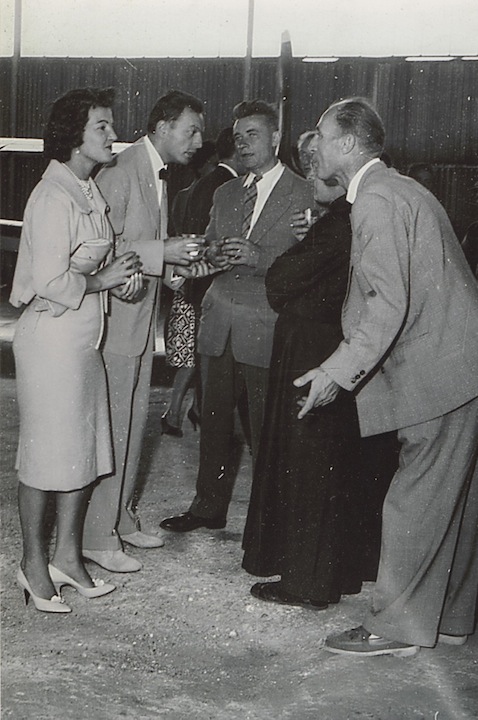
These pictures have been kindly sent by Régine Selosse, Julien's daughter, who was then 7. When she read my article in the French "Cahiers du RSA" (translated as "Restoring F-PGLT" for Bucker.info) she was shot by a strong rush of adrenaline as it made this wonderful kid's memory come vividly alve.
She offered me the pictures and her father's book, posthumously dedicated through her hand:
"For having rebuilt the most beautiful of my memories... and also for your career as a pilot, which I wanted so much for myself.
From the paradise of pilots, where I rest.
Julien"
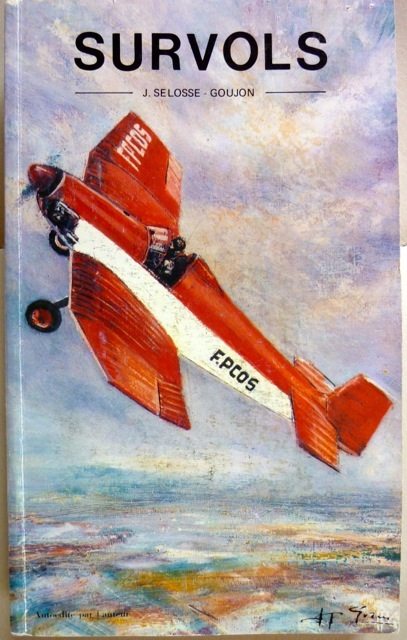
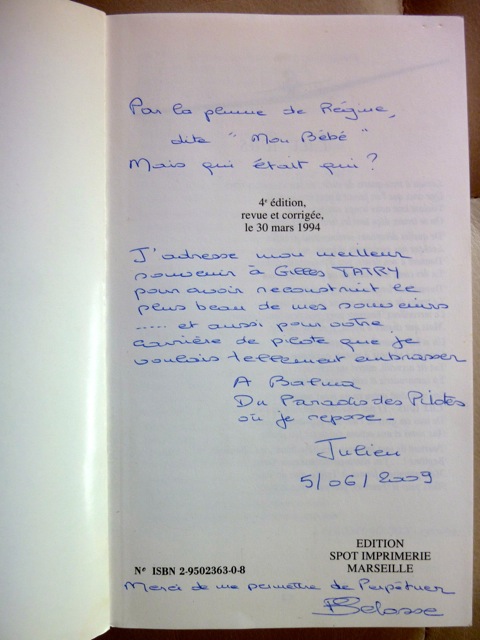
The Jungmann colors were orange and black, as repainted after recovering (without Binacotto's hand-written script), as for my first solo flight:
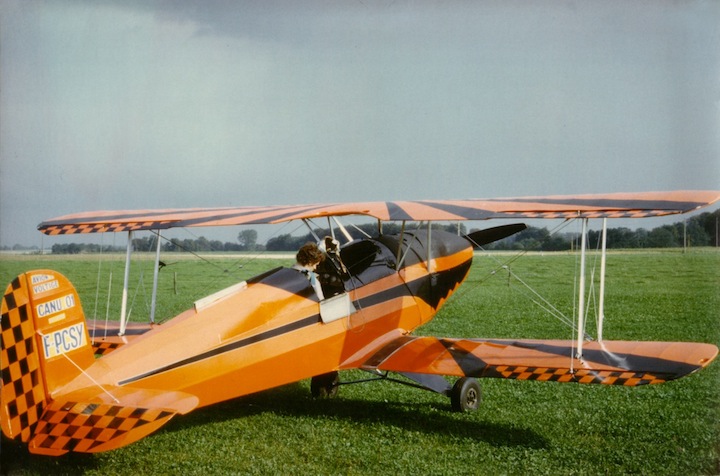
- Written by: Administrator
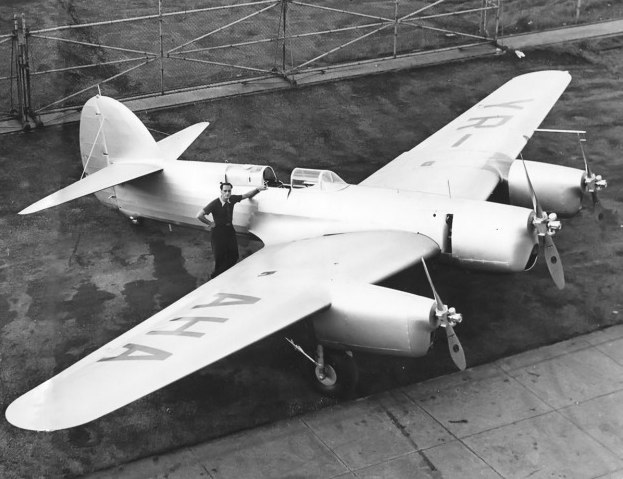
The Bellanca 28-92 had a Menasco C6 in each wing, and a Ranger V770 in the nose (neither of which were known for their reliability.) The 28-92 had a range of 3,000 miles at 250 mph.
There were problems with the test flights and Papana had a disagreement with the factory which resulted in the cancellation of the order, and of the proposed flight. The aircraft did take part in a number of famous races though, before ending its days derelict somewhere in Ecuador.
Much information here.
- Written by: Administrator
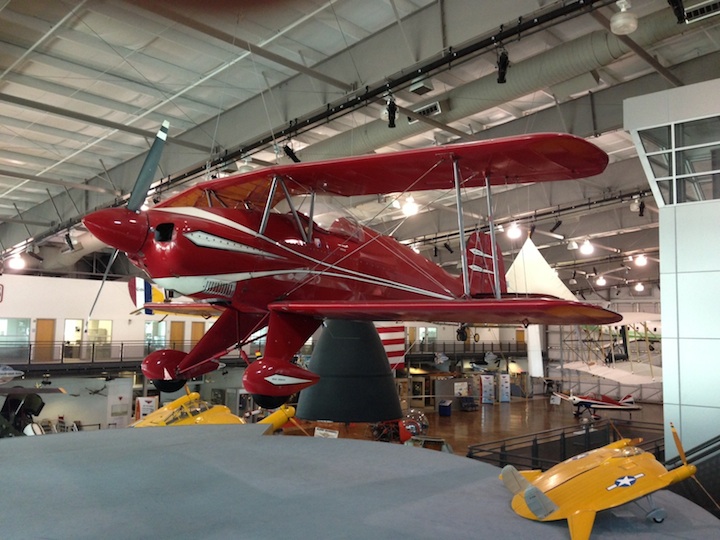
- Written by: Administrator
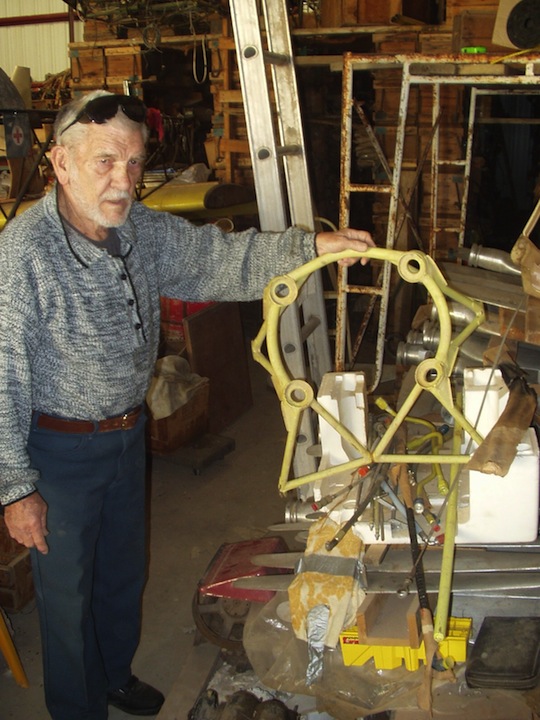
I only met Marcus twice, although I emailed and spoke to him on the telephone many times. By the time I started communicating with him and his wife Joann in the mid 1980s he had become very deaf, so telephone conversations were not always easy. "Do you have any wheels?" you might have asked. "Just a minute" Joann would reply. Then through a muffled microphone would be heard, "MARCUS - DO WE HAVE ANY WHEELS?" "WHAT?" "DO WE HAVE ANY WHEELS?" "WHAT SORT OF SEALS?" "NO, WHEELS!" . . . Marcus' hearing wasn't that much of an impediment though. It had become part of his character and part of his charm. Marcus would usually sign his emails or his forum posts "Marcus the Greater" :).
Part of the reason I am writing this is that I would like to know more. If anyone reading this has stories, anecdotes or information about the Bates, I would love to collect them for this website. Let's try not to lose any of these wonderful memories and do what we can to preserve Marcus and Joann's contribution to our lives. He was probably best known as an importer of Spanish CASA 1.131, but he was much more than that.
I'll start by recounting the story of my visit to Bates Field, West Texas in 2005 (I think)
Tom Muller at one time sold a Jungmann to Buzz Hurt in West Texas, and I had the privilege of delivering it. After enjoying Buzz's company for a little while, he suggested we pay a visit to Marcus and Joann, who lived not too far away. Buzz had a new litter of puppies at his ranch, and one had been promised to the Bates, so we would take it with us.
After a short drive, we took an unmarked turning and approached the airfield. There was no doubt we were in the right place:

The runway at Bates field is a brilliant white. It is built from compacted caliche, a form of calcium carbonate so soft that it feels like talc and polishes metal propellers to a brilliant shine. There is no missing it. Down the runway on the right, we saw the house. Also hard to miss since there were two Antonov AN2s in front of it.
I was flattered that Marcus and Joann not only remembered me but greeted me like an old friend. It was not because of anything I had done, it was because that was the way they greeted everyone. Everyone that didn't work for the government, that is :). We talked for a while and played with the puppy, but the evening was drawing on and everyone was tired. I asked if I might come back the next day and left for the hotel.
The next morning, in a truck Buzz had loaned me, I drove again to Bates Field. In the large kitchen, we sat at the table, had some tea and homemade muffins, and talked at length. We talked about Marcus' trips to Spain, the process of importing the CASA Jungmann, the people he had met, and the problems he had encountered with "the Feds" (US federal government.) I think it is fair to say that Marcus was not a fan of the government :).
After some hours, it was time to visit the hangar. What a place! There are aircraft and parts everywhere. A Glasair 1, Joann's Cessna, an unfinished Super Chipmunk that Leon Davis had built in the style of Harold Krier and "Pappy" Spinks, and everywhere you looked, Bucker parts. More than 50 engines, wings, tails, and rows and rows of wooden boxes - so many that they had been used to build walls and a second story erected on top.
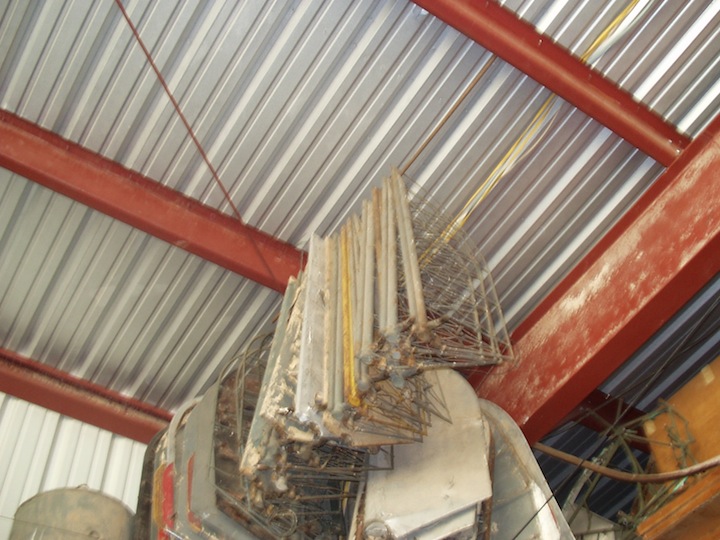
Fins, rudders, and elevators
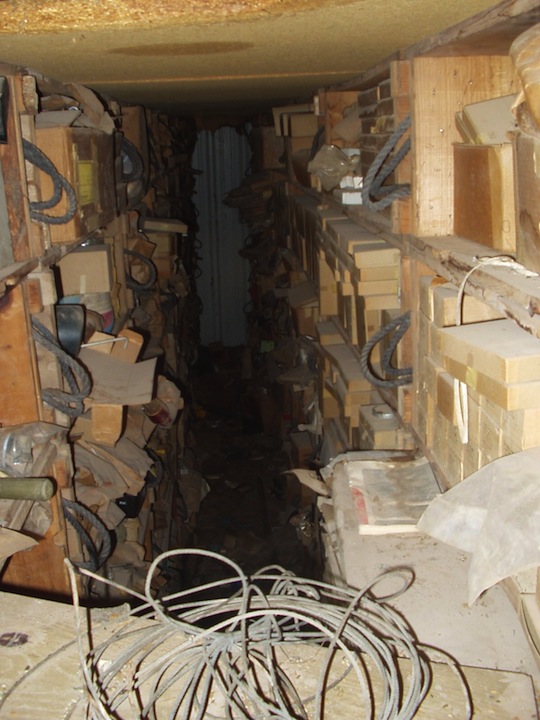
Boxes of goodness knows what!
There were canyons of boxes, and with his hearing difficulties, Marcus wasn't anxious to go down them and risk encountering a rattle snake. I didn't see or hear any, but he assured me they were there!
We poked around the hangar for a long time. We checked out the crates, counted the engines, looked over the Jungmeister project he was working on, and then, having taken up rather too much of his time, we went back to the house to say our goodbyes. There was another surprise in store.
They had prepared two gifts for me. One was a set of tail wheel steering cables/springs for my project, the other a shoebox in which Joann had packed muffins, water, a ham sandwich, a cookie and an apple. "You can't eat that stuff they give you on airplanes," she said. What a sweetheart.
And that was my visit. Thank you for your help Marcus, and thank you for your time and your advice. It was a most wonderful privilege to know you.
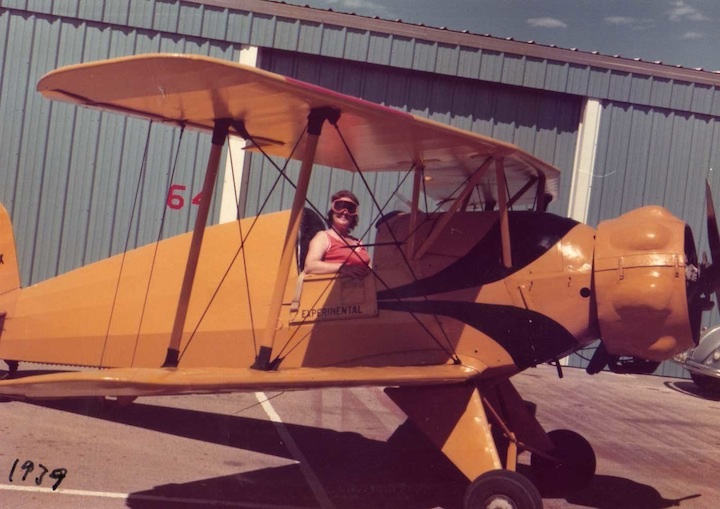
Joann Bates sitting in a Jungmeister obtained from Jennings Carter of Monroeville, Alabama in about 1979
More pictures soon.
- Written by: Hermann Diebold
Last week two representatives of the ancient days of Bücker flying met again after 35 years.
I had visited Werner v. Arx in his Museum at Basel airport Switzerland last year.
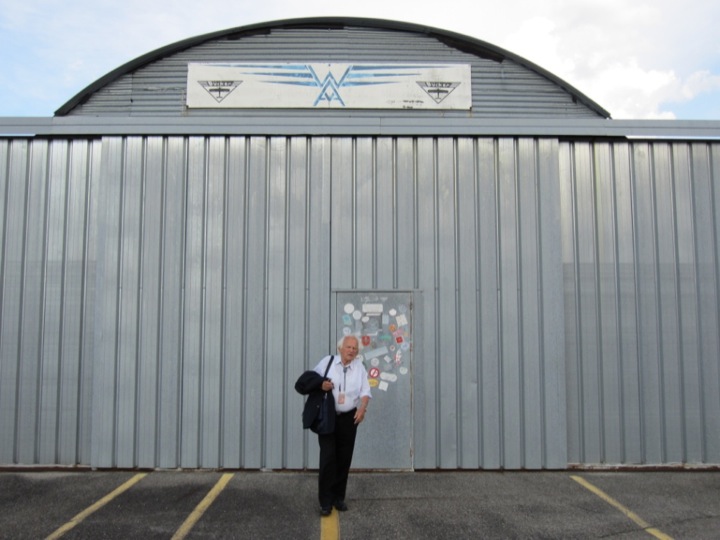
From Werner I learned that Werner v. Arx and Fritz Ulmer from Germany had owned several Bückers in their career and that they have many stories to tell how the Bückers changed hands from the Swiss and Spanish military to private aero clubs or private parties.
Both Fitz and Werner are now 88 years old, and it was pleasure for me to bring these two guys together after so many years of not having seen each other. Werner came to Göppingen by train and rang the door bell at Fritz Ulmers home. Fritz did not know about Werner`s visit, we did not want to make Fritz nervous ahead of the meeting. Fritz Ulmer`s wife Linda helped us and she had everything well prepared. Surprise surprise!! When Fitz recognized his old bucker fellow Werner v. Arx he was really excited.
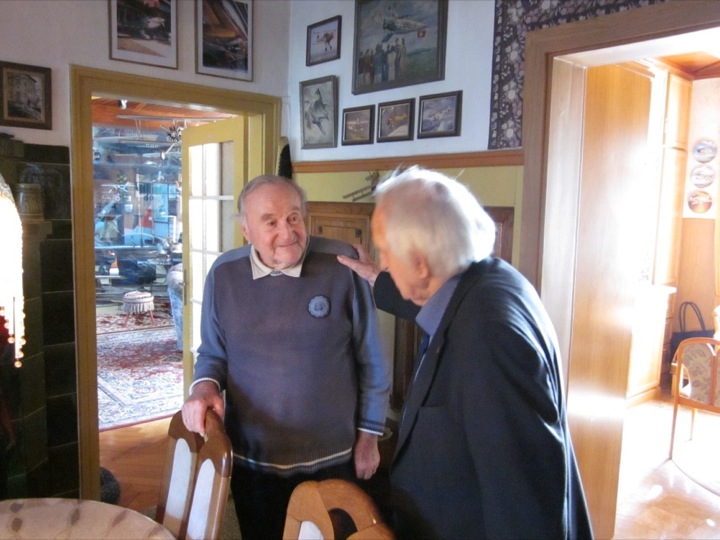
So they sat down for a first chat and then had a beer. Five hours of talks, stories, memories about the Bücker history was exchanged between the two enthusiasts. Everything has been recorded so that the younger Bücker fellows will have the priviledge to hear what these Bücker friends did and what experiences they had over so many years of Bücker flying.
Fritz attended over 60 airshows with his wonderful Bücker planes that he still owns. He enjoys to watch the planes in his studio while sitting in his living room and having a glass of good German red wine in the evening. The planes will all go to Museums in Germany when Fritz will not be with us any more.
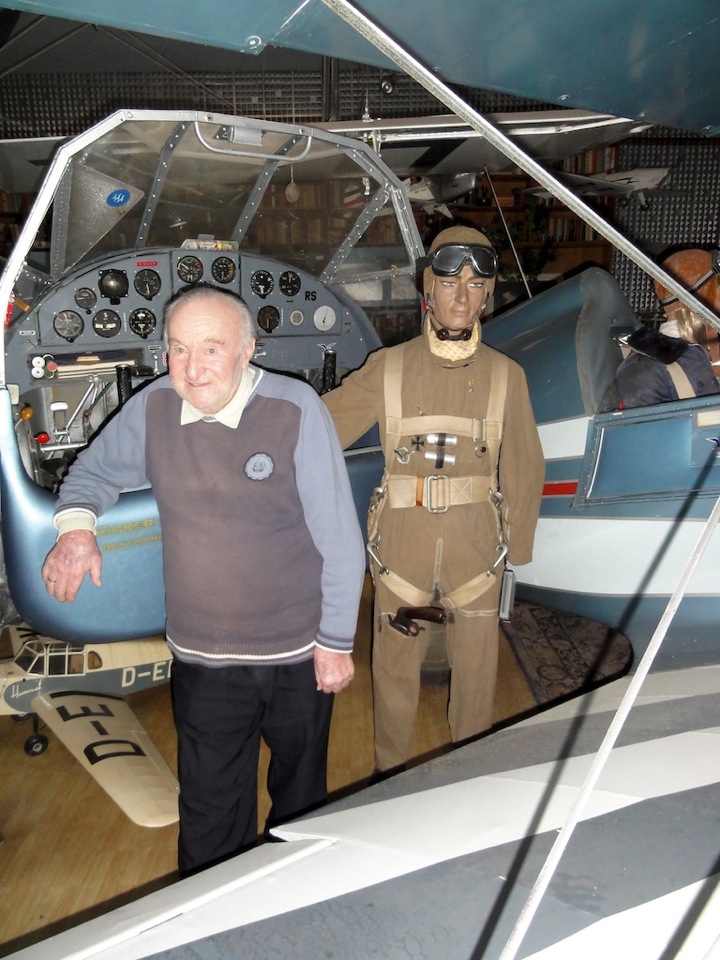
Fritz bought his first Jungmann from Werner and the contract was a handshake. And this is how they were “dealing” their Bückers all over the years. Fritz had 6 Bückers in his career, Werner owned 7 Bückers. They told stories how they flew over the alps transferring Bückers from here to there. Amazing stories, sometimes dangerous situations they went through. But finally they never ever had serious problems when flying their beloved Bücker planes.
We will write down their stories in its entirety and share it with the Bücker community in the future.
- Written by: Hermann Diebold
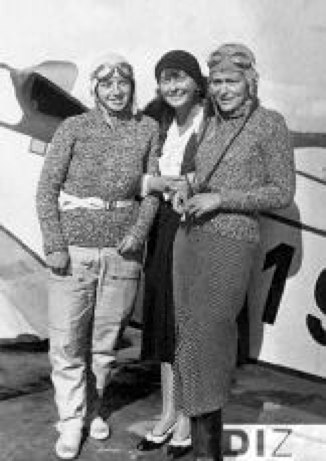
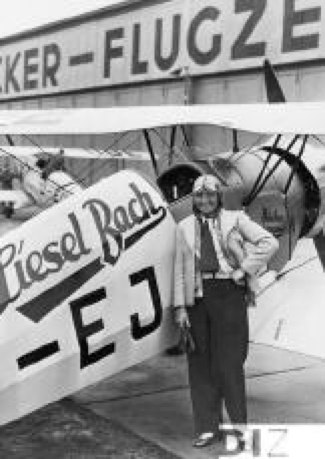
Now another young German lady is flying Jungmann and Jungmeister.
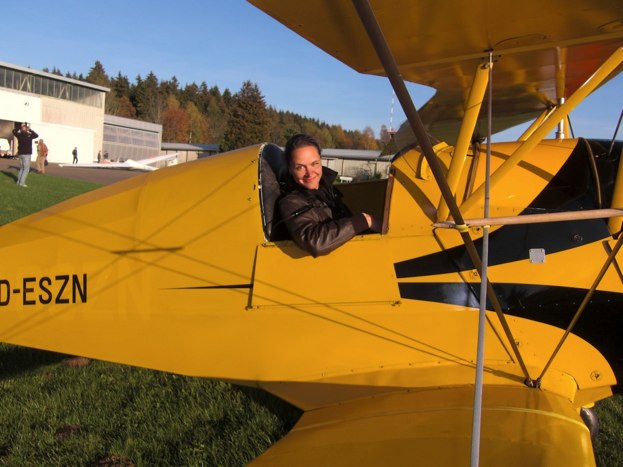
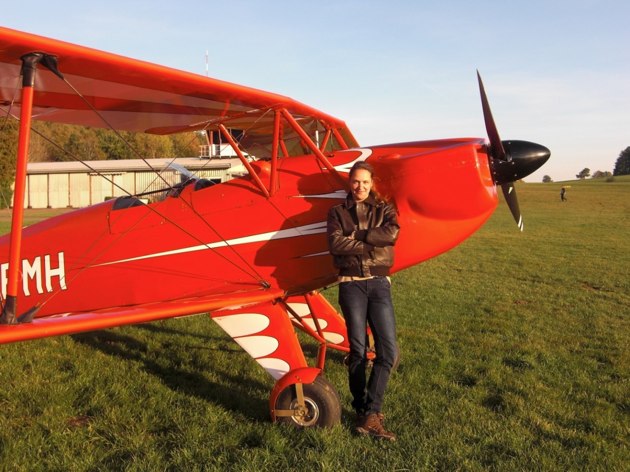
This year Kerstin Abrecht joined the group of German Bücker enthusiasts. One day she showed up at Degerfeld together with Peter Ulmer (son of the famous owner of the private Bücker museum in Göppingen) and asked us whether she could fly with Jürgen Hüfner`s Lycoming powered Bücker 131.
After only a few takeoffs with Jürgen in the front seat he noticed that she can really fly these planes without any problems. So she made the next step and flew in our Jungmeister.
Now we know why: Kerstin has 8000 hrs. of flying experience, 200 hrs. of aerobatic time on mostly Zlin, Yak 55 and Pitts aircraft. For living she is flying Boeing 737 as PIC.
We are very proud to see her fly these beautiful planes. Kerstin is considering it to be a great privilege to be invited to use the Jungmann and our Jungmeister.
Hermann Diebold, Jürgen Hüfner (proud owners of Bücker Jungmeister D-ESZN)

